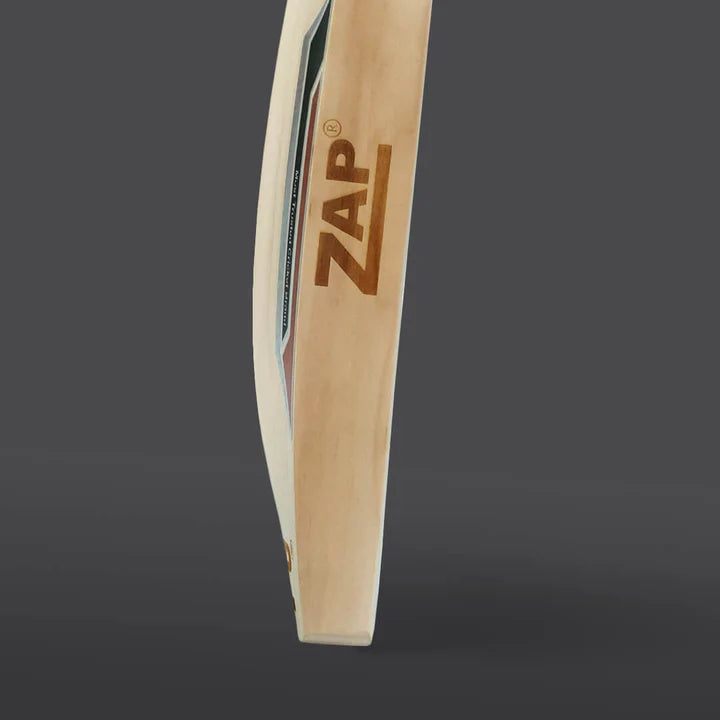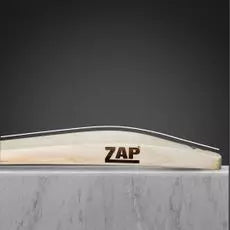The cricket bat is a cricketer’s first and ultimate companion in the sport, especially for a batsman. Knowing and understanding every tiny detail about a cricket bat is important for their success as a batter. This understanding helps in maximizing performance on the field. Playing at the highest level requires bats that can help maximize performance and bring out the best in the player. The best way to achieve this is by crafting your own custom cricket bat. However, there are numerous intricate details involved in making a bat, and tuning each detail according to your preference is essential. One such crucial detail is the sweet spot of a bat, which is the centre of all power in the willow weapon. It is the point from which a ball flies off after contact.

In this article by ZAP, let’s understand everything about the sweet spot of a cricket bat and how it impacts overall performance as a batter.
What is the Sweet Spot of a Cricket Bat?
A cricket bat has a very customary design, and not many evolutions have taken place in the shape of a bat. It has a bowing blade that is thinner on the upper side of the bat, gets thicker up until 75% from the top, and then gets thinner again. That’s what a standard, modern cricket bat looks like.

Now, the sweet spot of a cricket bat is that part where the thickness of the bow is maximum, and owing to that, it can generate the maximum power while playing a cricket shot. When looking from the face, it lies at the centre of the willow, on the front side of the thickest part of the bat. It's the area on the face of the, where the leather ball should ideally make contact, providing the perfect combination of power, accuracy, and control. And what better sound in the world than that of a leather ball hitting the sweet spot? This part is where the maximum transfer of energy from the bat to the shot happens. The sweet spot is like the perfect spot for hitting the ball. When you hit the ball there, it feels just right because the bat can transfer the energy back into the ball really well. A good hit from the sweet spot can make the ball go farther and get the player more runs. It also lowers the chance of mistiming your shot, which means you're less likely to get caught or out.
The Physics of the Sweet Spot:
The sweet spot shows an interesting phenomenon of physics. It is the point where the ball's impact and the bat's natural frequency converge perfectly, resulting in resonance. The vibrations and shock from a shot that is played off the sweet spot or the middle are minimal. Additionally, when a shot is struck from the centre, the power of the shot is increased because the sweet spot on the face is backed by the thickest part of the bat. This thickest part is heavy, and a much more effective transfer of energy and momentum happens when you strike the leather ball, sending it to the stars. The energy transfer is less effective when it is hit off-center because some of the energy is absorbed by the willow rather than being transmitted to the ball. It travels less quickly and farther as a result of this.
- If the shot is played off the sweet spot and is perfectly timed, the ball will be returned at a much greater speed. It will be like the red leather sphere is travelling towards the boundaries at lightning speed.
- But if the shot is mistimed or is edged, it won't have much power, and the speed of the ball after the impact wouldn’t be much higher.
- In a scientific way, the ratio of the speed of the ball to the speed off the bat is called E, and it varies depending on where it hits the bat, being smaller near the tip and edges and larger halfway up the willow.
The Different Types of Sweet Spots on a cricket bat:
The position and size of the sweet spot on a cricket bat can vary due to factors like the bat's design, weight distribution, and the quality of the willow used. Typically, the aim is to keep the sweet spot around the lower middle edge of the blade to balance power and control, but there are three different types of sweet spots you can have based on their position and the type of batting they suit.
Middle Peak Profile:

A middle profile usually has a higher sweet spot and is for players who bat at the top of the order and prefer playing on their back foot, playing shots like the square cut, pull shot, and others. Sachin Tendulkar was known to use a middle profile bat, which helped him get a better overall balance.
Middle to Low Profile:

The mid-to-low profile has a middle-to-lower sweet spot and is the most widely used bat profile. If you’re hitting big and playing in the middle order, this profile is perfect for your playing style. It is mainly played on pitches that are not very bouncy.
Low Profile:

A low-profile bat is mainly designed for players in the lower middle order and has sweet spots at the lower ends of the willows. It is typically used to hit low-lying deliveries for sixes. This is a POWER BAT profile.
How to increase power at the Sweet spot of the Cricket Bat?
There’s a common misconception that the thicker the edge of the bat, the more power the sweet spot has. To some extent, it stands true, but not in most cases. Having a thicker edge means a heavier bat that compromises on the overall balance and feel. No batsman can ever compromise on how balanced their bat feels for some extra shot power. And the strength of a cricket bat depends more on the quality of the willow used than only on the thickness of its edge. So, focus on getting the balance right and use a good quality willow for your cricket bat.

Also, taking good care of your bat, like knocking it well before taking it out to play and oiling it to ensure the willow fibres remain intact, can also help you add more power to your shots and expand the overall prime hitting area on the face of the cricket bat.
Now that you have read and know everything about a cricket bat, here are some more article we recommend you read:
Cricket Bat Knocking | English Willow vs Kashmir Willow | How are leather cricket balls made



Share:
The Story of India's 2011 ICC ODI Cricket World Cup Triumph
Pakistan National Cricket Team: Players, ICC Trophies and Records